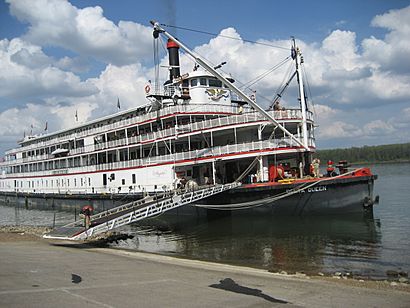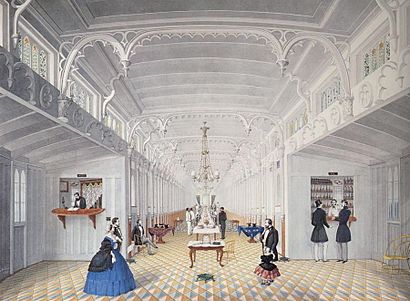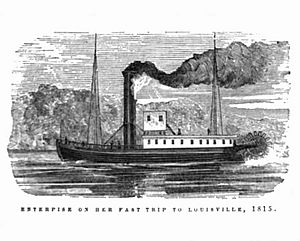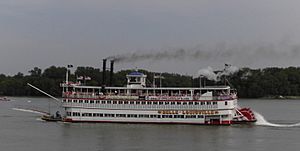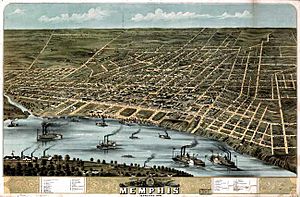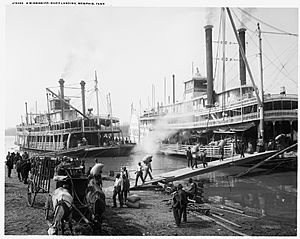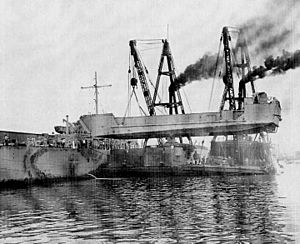Steamboats of the Mississippi facts for kids
Steamboats played a major role in the 19th-century development of the Mississippi River and its tributaries, allowing practical large-scale transport of passengers and freight both up- and down-river. Using steam power, riverboats were developed during that time which could navigate in shallow waters as well as upriver against strong currents. After the development of railroads, passenger traffic gradually switched to this faster form of transportation, but steamboats continued to serve Mississippi River commerce into the early 20th century. A small number of steamboats are still used for tourist excursions in the 21st century.
Contents
- Geography
- Background
- Golden age of steamboats
- Construction of the vessels
- The steamers Natchez
- Improved navigation
- Major ports
- Mark Twain
- Boiler explosions
- Gambling
- Regulation
- Steamboat Act of May 30, 1852
- Showboats
- In Oklahoma
- Civil War Service
- Reconstruction
- The Great Race
- Competition from the railroads
- Rise of barge traffic
- Flood of 1927
- Mississippi River Commission
- US Army Corps of Engineers
- Tennessee Valley Authority Project
- World War II LST construction
- End of steamboats
- Current Natchez
Geography
The Mississippi is one of the world's great rivers. It spans 3,860 miles (6,210 km) of length as measured using its northernmost west fork, the Missouri River, starting in the Rocky Mountains in Montana, joining the Mississippi proper in the state of Missouri. The Ohio River and Tennessee River are other tributaries on its east, and the Arkansas, Platte, and Red River of Texas come from the west. The Mississippi itself starts at Lake Itasca in Minnesota, and the river proceeds through the center of the country, forming parts of the boundaries of ten states, dividing east and west, and furthering trade and culture in those regions and beyond.
Background
Steamboats on the Mississippi benefited from technology and political changes leading up to their introduction. The US bought the Louisiana Territory from France in 1803. At the time, a semi-bankrupt Napoleon was attempting to extend his hegemony over Europe in what came to be known as the Napoleonic Wars. As a result, the US was then free to expand westward out of the Ohio valley and into the Great Plains and the Southwest.
The success of the Charlotte Dundas in Scotland in 1801 and Robert Fulton's Clermont on the Hudson River in 1807 proved the viability of the steamboat. At this time, walking beam mill engines, of the Boulton and Watt variety, were dropped onto wood barges with paddles to create an instant powerboat. The overhead engines of the "walking beam" type became the standard Atlantic Seaboard paddle engine for the next 80 years. For smaller boats, Watt perfected the side-lever engine with the engine cut down using side bell-cranks to lower the center of gravity. Sidewheel paddlers were the first to enter the scene. In 1811, the steamer New Orleans was built in Pittsburgh for Fulton and Livingston. Fulton started steamboat service between Natchez and New Orleans.
The War of 1812 caused political upheaval in the south, particularly with the Royal Navy blockade of the US Gulf Coast ports, but after the Treaty of Ghent and resumption of peace, New Orleans was firmly American after passing through French and Spanish hands. New Orleans thus became the great port on the mouth of the Mississippi.
Golden age of steamboats
The historical roots of the prototypical Mississippi steamboat, or Western Rivers steamboat, can be traced to designs by easterners like Oliver Evans, John Fitch, Daniel French, Robert Fulton, Nicholas Roosevelt, James Rumsey, and John Stevens. In the span of six years, the evolution of the prototypical Mississippi steamboat was well underway, as seen by the introduction of the first vessels:
- New Orleans, or Orleans, was the first Mississippi steamboat. Launched in 1811 at Pittsburgh, Pennsylvania, for a company organized by Robert Livingston and Robert Fulton, her designer, she was a large, heavy side-wheeler with a deep draft. Her low-pressure Boulton and Watt steam engine operated a complex power train that was also heavy and inefficient.
- Comet was the second Mississippi steamboat. Launched in 1813 at Pittsburgh for Daniel D. Smith, she was much smaller than the New Orleans. With an engine and power train designed and manufactured by Daniel French, the Comet was the first Mississippi steamboat to be powered by a lightweight and efficient high-pressure engine turning a stern paddlewheel.
- Vesuvius was the third Mississippi steamboat. Launched in 1814 at Pittsburgh for the company headed by Robert Livingston and Robert Fulton, her designer, she was very similar to the New Orleans.
- Enterprise, or Enterprize, was the fourth Mississippi steamboat. Launched in 1814 at Brownsville, Pennsylvania, for the Monongahela and Ohio Steam Boat Company, she was a dramatic departure from Fulton's boats. The Enterprise - featuring a high-pressure steam engine, a single stern paddle wheel, and shoal draft - proved to be better suited for use on the Mississippi compared to Fulton's boats. The Enterprise clearly demonstrated the suitability of French's design during her epic voyage from New Orleans to Brownsville, a distance of more than 2,000 miles (3,200 km), performed against the powerful currents of the Mississippi and Ohio rivers.
- Washington was launched in 1816 at Wheeling, West Virginia, for Henry Shreve and partners. George White built the boat and Daniel French constructed the engine and drivetrain at Brownsville. She was the first steamboat with two decks, the predecessor of the Mississippi steamboats of later years. The upper deck was reserved for passengers and the main deck was used for the boiler, increasing the space below the main deck for carrying cargo. With a draft of 4 feet (1.2 m), she was propelled by a high-pressure, horizontally mounted engine turning a single stern paddlewheel. In the spring of 1817, the Washington made the voyage from New Orleans to Louisville in 25 days, equalling the record set two years earlier by the Enterprise, a much smaller boat.

The steamboat was an ideal solution for the growing country while America boomed in the age of President Andrew Jackson. In the 1810s there were 20 boats on the river; by the 1830s, there were more than 1200. By the 1820s, with the Southern states joining the Union and the land converted to the cotton plantations so indicative of the Antebellum South, methods were needed to move the bales of cotton, rice, timber, tobacco, and molasses. A large portion of the population had moved west, and more farms were established. In the 1820s, steamers were fueled first by wood, then coal, which pushed barges of coal from Pittsburgh to New Orleans. Regular steamboat commerce began between Pittsburgh and Louisville.
Construction of the vessels
Vessels were made of wood—typically ranging in length from 40 feet (12 m) to nearly 300 feet (91 m) in length, 10 feet (3.0 m) to 80 feet (24 m) wide, drawing only about one to five feet of water loaded; it was commonly said that they could "navigate on a heavy dew." The boats had kingposts, or internal masts, to support hogchains, or iron trusses, which prevented the hull from sagging. A second deck was added, the Texas Deck, to provide cabins and passenger areas. Everything was constructed from wood. Stairs, galleys, and parlors were also added. Often the boats became quite ornate with wood trim, velvet, plush chairs, gilt edging, and other trimmings, sometimes per the owner's taste and budget. Wood burning boilers were placed forward-center to distribute weight. The engines were amidships or at the stern, depending on if the vessel was a sternwheeler or sidewheeler. Two rudders were fitted to help steer the ship.
On average, vessels lasted only about five years due to the wooden hulls being breached, poor maintenance, fires, general wear and tear, and the common boiler explosion. Early trips up the Mississippi River took three weeks to arrive at the Ohio River. Later, with better pilots, more powerful engines and boilers, removal of obstacles, and experienced rivermen who knew the location of sandbars, that figure was reduced to 4 days. Collisions and snags were constant perils.
The steamers Natchez
Natchez I
The first Natchez was a low-pressure sidewheel steamboat built in New York City in 1823. It originally ran between New Orleans and Natchez, Mississippi, and later catered to Vicksburg, Mississippi. Its most notable passenger was Marquis de Lafayette, the French hero of the American Revolutionary War, in 1825. Fire destroyed it while in New Orleans on September 4, 1835.
Natchez II
Natchez II was the first built for Captain Thomas P. Leathers, at Crayfish Bayou, and ran from 1845 to 1848. It was a fast two-boiler boat, 175 feet (53 m) long, with red smokestacks, that sailed between New Orleans and Vicksburg, Mississippi. It was built in Cincinnati, Ohio and Leathers sold it in 1848, and was later abandoned in 1852.
Natchez III
Natchez III was funded by the sale of the first vessel. It was 191 feet (58 m) long. Leathers operated it from 1848 to 1853. On March 10, 1866, it sank at Mobile, Alabama due to rotting.
Natchez IV
Natchez IV was built in Cincinnati, Ohio. It was 270 feet (82 m) long, had six boilers, and could hold 4,000 bales of cotton. It operated for six weeks. On January 1, 1854, the ship collided with the Pearl at Plaquemine, Louisiana, causing the Pearl to sink. A wharf fire on February 5, 1854 in New Orleans caused it to burn down, sharing in the same fate as several other ships.
Natchez V
Natchez V was also built in Cincinnati, as Captain Leathers returned there quickly after the destruction of the third ship to bear the name. It also operated six boilers, but this one could hold 4,400 cotton bales. This vessel was used by Leathers until 1859. In 1860, it was destroyed while serving as a wharf boat at Baton Rouge, Louisiana.
Natchez VI
Natchez VI was again a Cincinnati-built boat; it measured 273 feet (83 m) long. The capacity was 5,000 cotton bales, but the power remained the same. It helped transport Jefferson Davis from his river plantation home on the Mississippi River after he heard he was chosen as the President of the Confederacy. Even after the war, Davis insisted on using Leather's boats to transport him to and from his plantation, Brierfield. Natchez VI was also used to transport Confederate troops to Memphis, Tennessee. After Union invaders captured Memphis, the boat was moved to the Yazoo River. On March 13, 1863, it was burned either by accident or to keep it out of Union hands at Honey Island. Remains were raised from the river in 2007.
Natchez VIII
Natchez VIII was launched on August 2, 1879, by the Cincinnati Marine Ways. It was 303.5 feet (92.5 m) long, with a beam of 45.5 feet (13.9 m), 38.5 feet (11.7 m) floor, and 10 feet (3.0 m) hold depth. It had eight steel boilers that were 36 feet (11 m) long and had a diameter of 42 inches (1,100 mm), and thirteen engines. It had 47 elegant staterooms. Camp scenes of Natchez natives war-dancing and sun-worshipping ornamented the fore and aft panels of the main cabin, which also had stained glass windows depicting Native Americans. The total cost of the boat was $125,000. Declaring that the War was over, on March 4, 1885, Leathers raised the American flag when the new Natchez passed by Vicksburg, the first time he hoisted the American flag on one of his ships since 1860. By 1887, lack of business had stymied the Natchez. In 1888, it was renovated back to perfect condition for $6000. In January 1889, it burned down at Lake Providence, Louisiana. Captain Leathers, deciding he was too old to build a new Natchez, retired. Jefferson Davis sent a letter of condolences on January 5, 1889 to Leathers over the loss of the boat. Much of the cabin was salvageable, but the hull broke up due to sand washing within.
In 1824, Congress passed the "Act to Improve the Navigation of the Ohio and Mississippi Rivers" and "to remove sand bars on the Ohio and planters, sawyers, and snags on the Mississippi". The Army Corps of Engineers was given the job. In 1829, surveys were completed of the two major obstacles on the upper Mississippi, the Des Moines Rapids and the Rock Island Rapids, where the river was shallow and the riverbed was rocky. The Des Moines Rapids were about 11 miles (18 km) long and, traveling upriver, began just above the mouth of the Des Moines River at Keokuk, Iowa. The Rock Island Rapids were between Rock Island and Moline, Illinois. Both rapids were considered virtually impassable.
The Army Corps of Engineers recommended the excavation of a 5 ft (1.5 m) deep channel at the Des Moines Rapids, but work did not begin until after Lieutenant Robert E. Lee endorsed the project in 1837. In 1848, the Illinois and Michigan Canal was built to connect the Mississippi River to Lake Michigan via the Illinois River near Peru, Illinois. The Corps later also began excavating the Rock Island Rapids. By 1866, it had become evident that excavation was impractical, and it was decided to build a canal around the Des Moines Rapids. That canal opened in 1877, but the Rock Island Rapids remained an obstacle.
Major ports
St. Louis
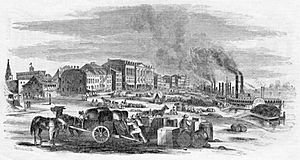
St. Louis became an important trade center, not only for the overland route for the Oregon and California trails, but as a supply point for the Mississippi River. Rapids north of the city made St. Louis the northernmost navigable port for many large boats. The Zebulon Pike and her sisters soon transformed St. Louis into a bustling boomtown, commercial center, and inland port. By the 1830s, it was common to see more than 150 steamboats at the St. Louis levee at one time. Immigrants flooded into St. Louis after 1840, particularly from Germany. During Reconstruction, rural Southern blacks flooded into St. Louis as well, seeking better opportunities.
By the 1850s, St. Louis had become the largest U. S. city west of Pittsburgh, and the second-largest port in the country, with a commercial tonnage exceeded only by New York. James Eads was a famed engineer who ran a shipyard and first built riverboats in the 1850s, then armed riverboats and finally the legendary bridge over the Mississippi. His Mound City Ironworks and shipyard were famous and were featured often in the naming of vessels.
Memphis
Memphis became another major port on the Mississippi. However, as a slave port, the city had been contested in the Civil War, with Union forces and Confederate forces vying for control of the port.
The First Battle of Memphis was a naval battle fought on the Mississippi River immediately above the city of Memphis on June 6, 1862, during the American Civil War. The engagement was witnessed by many of the citizens of Memphis and it resulted in a crushing defeat for the Rebels, marking the virtual eradication of the Confederate naval presence on the river. Despite the lopsided outcome, the Union Army failed to grasp its strategic significance. Its primary historical importance is that it was the last time civilians with no prior military experience were permitted to command ships in combat.
Tom Lee Park on the Memphis riverfront is named for an African-American riverworker who became a civic hero. Tom Lee could not swim; nevertheless, he single-handedly rescued thirty-two people from drowning when the steamer M.E. Norman sank in 1925.
Washington, Louisiana
Washington, Louisiana, is not located directly on the Mississippi River, more than 30 miles west of the Mississippi on Bayou Courtableau; Nevertheless, the port there was the largest between New Orleans and St. Louis during much of the 19th century. Products such as cotton, sugar, and livestock were brought to Washington overland or by small boat and then transferred to the steam packets for shipment to New Orleans. By the mid-19th century, Washington developed a thriving trade and became the most important port in the vicinity of St. Landry Parish. This can be seen in the number of steamers that used the port and in the volume of freight. In 1860, there were 93 steam packets operating in the Bayou Courtableau trade, as compared to 90 in Bayou Lefourche and 94 in Bayou Teche. An 1877 tabulation showed the total quantity of goods shipped from Washington to New Orleans: 30,000 bales of cotton, 32,000 sacks of cottonseed, 3,000 hogsheads of sugar, 5,800 barrels of molasses, and 30,000 dozen poultry. As many as 93 packets came to Washington during the steamboat era, which ended in 1900.
Mark Twain
Many of the works of Mark Twain deal with or take place near the Mississippi River. One of his first major works, Life on the Mississippi, is in part a history of the river, in part a memoir of Twain's experiences on the river, and a collection of tales that either take place on or are associated with the river. Twain's most famous work, Adventures of Huckleberry Finn, is largely a journey down the river. The novel works as an episodic meditation on American culture with the river having multiple different meanings including independence, escape, freedom, and adventure.
Twain himself worked as a riverboat pilot on the Mississippi for a few years. A steamboat pilot needed a vast knowledge of the ever-changing river to be able to stop at any of the hundreds of ports and wood-lots along the river banks. Twain meticulously studied 2,000 miles (3,200 km) of the Mississippi for two and a half years before he received his steamboat pilot license in 1859. While training, he convinced his younger brother Henry to join him, although Henry died on June 21, 1858, when the steamboat he was working on, the Pennsylvania, exploded.
Boiler explosions
Between 1811 and 1853, an estimated 7,000 fatalities occurred as a result of catastrophic boiler explosions on steamboats operating on the Mississippi and its tributaries. Due to a combination of poor boiler construction and unsafe operation, steamboat explosions were a frequent occurrence. Charles Dickens commented on the issue in his 1842 travelogue American Notes, writing, "...[American] steamboats usually blow up one or two a week in the season."
Boilers used in early Mississippi steamboats were constructed from many small pieces of riveted cast iron, as the process to produce larger, stronger sheets of metal had not yet been developed. Most suffered from poor workmanship in their construction and were prone to failure. The inherent danger of these boilers was further compounded by widespread unsafe practices in their operation. Steamboat engines were routinely pushed well beyond their design limits, tended by engineers who often lacked a full understanding of the engine's operating principles. With a complete absence of regulatory oversight, most steamboats were not adequately maintained or inspected, leading to more frequent catastrophic failures.
Due to the vast superiority riverboats then held over all forms of land transportation, passengers were willing to accept the high risk of a boiler explosion. Boat operators were not required to carry any kind of insurance and were not held liable for accidents, and so had little incentive to improve safety. Only after a great number of tragedies did this situation change. In 1825, the explosion of the Teche killed 60 people. In addition, the Ohio and the Macon both exploded the following year in 1826, the Union and the Hornet in 1827, the Grampus in 1828, the Patriot and the Kenawa in 1829, the Car of Commerce and the Portsmouth in 1830, and the Moselle in 1838.
Mark Twain described a boiler explosion that occurred aboard the steamboat Pennsylvania in 1858. Among the injured passengers was his brother, Henry Clemens, who had been fatally scalded by steam. Henry was taken to an improvised hospital, but died shortly after while accompanied by Twain. Twain later wrote of his brother's death: "For forty-eight hours I labored at the bedside of my poor burned and bruised but uncomplaining brother...and then the star of my hope went out and left me in the gloom of despair..."
On February 24, 1830, as the Helen McGragor prepared to pull away from the Memphis waterfront the starboard boiler exploded, most likely due to a failure to relieve excess pressure built up while the boat was stationary. The blast itself and flying debris killed a number of people, while about 30 others were scalded to death. On April 27, 1865, a damaged boiler on the Sultana exploded seven miles north of Memphis while carrying a massively overweight load of released Union army POWs. The initial blast, along with the fire that immediately followed, killed at least 1,192, making it the deadliest maritime disaster in U.S. history.
Gambling
Gambling took many forms on riverboats. There were card sharks willing to fleece the unsuspecting rube. As cities passed ordinances against gaming houses in town, the cheats moved to the unregulated waters of the Mississippi aboard river steamers.
There was also gambling with the racing of boats up the river. Bets were made on a favorite vessel. Pushing the boilers hard in races would also cause fires to break out on the wooden deck structures.
Regulation
One of the enduring issues in American government is the proper balance of power between the national government and the state governments. This struggle for power was evident from the earliest days of the American government and is the underlying issue in the case of Gibbons v. Ogden. In 1808, Robert Fulton and Robert Livingston were granted a monopoly by the New York state government to operate steamboats on the state's waters. This meant that only their steamboats could operate on the waterways of New York, including those bodies of water that stretched between states, called interstate waterways. This monopoly was important because steamboat traffic, which carried both people and goods, was very profitable. Aaron Ogden held a Fulton-Livingston license to operate steamboats under this monopoly and he operated steamboats between New Jersey and New York. However, Thomas Gibbons competed with Aaron Ogden on this same route. Gibbons did not have a Fulton-Livingston license, but instead had a federal (national) coasting license, granted under a 1793 act of Congress.
The United States at this time was a loose confederation of states. The federal government was weak, and so regulating vessels, even for gaming statutes, was an imposition on States Rights. The Interstate Steamboat Commerce Commission was finally set up in 1838 to regulate steamboat traffic. Boiler inspections only began in 1852.
Steamboat Act of May 30, 1852
The previous 1838 law proved inadequate as steamboat disasters increased in volume and severity. The period from 1847 to 1852 was marked by an unusual series of disasters, primarily caused by boiler explosions; however, many were also caused by fires and collisions. These disasters resulted in the passage of the Steamboat Act of May 30, 1852 (10 Stat. L., 1852) in which enforcement powers were placed under the Department of the Treasury, rather than the Department of Justice as with the Act of 1838. Under this law, the organization and form of a federal maritime inspection service began to emerge. Nine supervisory inspectors were appointed, each of them responsible for a specific geographic region. There were also provisions for the appointment of local inspectors by a commission consisting of the local District Collector of Customs, the Supervisory Inspector, and the District Judge. The important features of this law were the requirement for hydrostatic testing of boilers and the requirement for a boiler steam safety valve. The new law further required that both pilots and engineers be licensed by the local inspectors. Time and further insight proved the Steamboat Act inadequate; probably the most serious shortcoming was the exemption of freight boats, ferries, tugboats, and towboats, which continued to operate under the superficial inspection requirements of the law of 1838. Again, disasters and high loss of life prompted congressional action through the passage of the Act of February 28, 1871.
Showboats
A showboat (or show boat) was a form of theater that traveled along the waterways of the United States, especially along the Mississippi and Ohio rivers. A showboat was basically a barge that resembled a long, flat-roofed house; in order to move down the river, it was pushed by a small tugboat (misleadingly labeled a towboat) which was attached to it. It would have been impossible to put a steam engine on the showboat, since it would have had to have been placed in the auditorium.
British-born actor William Chapman, Sr. created the first showboat, named the "Floating Theatre," in Pittsburgh in 1831. He and his family performed plays with added music and dance at stops along the waterways. After reaching New Orleans, they got rid of the boat and went back to Pittsburgh in a steamboat in order to perform the process once again the year after. Showboats had declined by the Civil War, but began again in 1878 and focused on melodrama and vaudeville. Major boats of this period included the New Sensation, New Era, Water Queen, and the Princess. With the improvement of roads, the rise of the automobile, motion pictures, and the maturation of the river culture, showboats declined again. In order to combat this development, they grew in size and became more colorful and elaborately designed in the 20th century. These boats included the Golden Rod, the Sunny South, the Cotton Blossom, the New Showboat, and the Minnesota Centennial Showboat. Jazzmen Louis Armstrong and Bix Biederbecke played on Mississippi River showboats.
In Oklahoma
As the federal government removed the Cherokee, Choctaw, and Creek Nations to Oklahoma, the new immigrants and the military forces demanded supplies, creating a vigorous steamboat trade to the Mississippi River down to New Orleans or upstream to points north. At the peak of steamboat commerce, in the 1840s and 1850s, there were twenty-two landings between Fort Smith in present-day Arkansas, and Fort Gibson, with the most difficult point at Webbers Falls.
Civil War Service
The American Civil War spilled over to the Mississippi with naval sieges and naval war using paddlewheelers. The Battle of Vicksburg involved monitors and ironclad riverboats. The USS Cairo is a wrecked survivor of the Vicksburg battle. Trade on the river was suspended for two years because of a Confederate blockade. The triumph of Eads ironclads, and Farragut's seizure of New Orleans, secured the river for the Union.
The worst of all steamboat accidents occurred at the end of the Civil War in April 1865, when the steamboat Sultana, carrying an over-capacity load of returning Union soldiers recently freed from Confederate prison camp, blew up, causing more than 1,000 deaths.
Reconstruction
With the Union victory and occupation of the south, transport was administered by the US Army and Navy. The year 1864 brought an all-time low water mark on Upper Mississippi. Stern wheelers proved more adaptable than side wheelers for barges.
Immediately after the war, passenger steamboats became larger, faster, and more opulent; on the freight barges salt, hay, iron ore, and grain were carried. A few boats specialized in pushing huge log rafts downstream to lumber mills. By 1850, a system of moving barges and log rafts lashed alongside and ahead of the towboat was developed, which allowed greater control compared to towing on a hawser. This type of service favored sternwheel propelled boats over sidewheelers and promoted other improvements as well, and towboats became a distinct type by 1860. Sand and gravel for construction were dredged up from river bottoms and pumped aboard cargo barges. Simple hydraulic dredging rigs on small barges did the work. Towboats moved the dredge and sand barges around as needed.
The Great Race
Natchez VII was built in 1869. It was 301 feet (92 m) long, had eight boilers, and a 5,500 cotton bale capacity. In its 9+1⁄2-year service, it made 401 trips without a single deadly accident. It became famous as the participant against another Mississippi paddle steamer, the Robert E. Lee, in a race from New Orleans to St. Louis in June 1870, immortalized in a lithograph by Currier and Ives. This Natchez had beaten the previous speed record, that of the J. M. White in 1844. Stripped down, carrying no cargo, steaming on through fog, and making only one stop, the Robert E. Lee won the race in 3 days, 18 hours and 14 minutes. By contrast, the Natchez carried her normal load and stopped as normal, tying up overnight when fog was encountered. Despite this, she berthed only six hours later. When Leathers finally dismantled the boat in Cincinnati in 1879, this particular Natchez had never flown the American flag.
Competition from the railroads
Railroads were rebuilt in the south after the Civil War, the disconnected small roads, of 5-foot (1.5 m) broad gauge, were amalgamated and enlarged into the extensive systems of the southern Illinois Central and Louisville and Nashville. The track was changed to the American Standard of 4 feet and 88.5 inches. With this track, cars could travel from Chicago to the south without having to be reloaded. Consequently, rail transport became cheaper than steamboats; the boats could not keep up. The first railroad bridge built across the Mississippi River connected Davenport and Rock Island, IL in 1856, built by the Rock Island Railroad. Steamboaters saw nationwide railroads as a threat to their business. On May 6, 1856, just weeks after it was completed, a pilot crashed the Effie Afton steamboat into the bridge. The owner of the Effie Afton, John Hurd, filed a lawsuit against The Rock Island Railroad Company; the Rock Island Railroad Company selected Abraham Lincoln as their trial lawyer.
Rise of barge traffic
Freight tonnage on the Upper Mississippi fell below 1 million tons per year in 1916 and hovered around 750,000 tons until 1931. A number of factors had led to this decline. Log rafts and raft towboats had disappeared and river cargo service had shifted to short-haul instead of long distance hauling. The First World War made crewmen scarce and helped to make the railroads stronger. The deficiencies of railroad transportation during World War I led to the Transportation Act of 1920.
In spite of these problems, barge traffic exploded with the growth of trade from the First World War. The heavy transportation needs of wartime could not be met by railroads, and river transport took off some of the pressure. In 1917, the United States Shipping Board allocated $3,160,000 to the Emergency Fleet Corporation to build and operate barges and towboats on the Upper Mississippi. Federal control was augmented by the Federal Control Act of 1918. The U.S. Railroad Administration formed the Committee on Inland Waterways to oversee the work. All floating equipment on the Mississippi and Warrior River systems was commandeered and $12 million was appropriated for new construction. Service was provided primarily on the Lower Mississippi.
New floating equipment was designed by prominent naval architects and built by boatyards known for high-quality work. Modern terminal facilities were constructed to handle bulk and package freight. A special rate system was put into place to reflect the lower cost of river transportation in comparison with railroads. In spite of their innovative approach, the Railroad Administration lost money on river services and in 1920 the Federal Barge Fleet was transferred to the War Department.
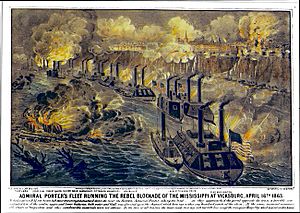
The name was changed to the Inland and Coastwise Waterways Service and the experiment continued. The Waterways Service lost less money compared to the Railroad Administration and in 1924 was modified yet again to allow for a more economic operation in a less restrictive environment. The government transferred $5 million worth of floating equipment to provide the capital stock for the new Inland Waterways Corporation.
Compression ignition or diesel engines were first used about 1910 for smaller sternwheel towboats, but the technology did not gain wide-spread use until the late 1930s, when diesel-powered propeller boats appeared. The introduction of screw propellers to the rivers came late because of their vulnerability to damage and the greater depth of water required for efficient operation. The Federal Barge Lines experiment was successful in restarting the river transportation industry.
Congress created the Inland Waterways Corporation (1924) and its Federal Barge Line. The completion of the nine-foot channel of the Ohio River in 1929 was followed by similar improvements on the Mississippi and its tributaries and the Gulf Intra-Coastal Canals. Each improvement marked a giant step by the United States Army Corps of Engineers in promoting inland waterways development. Private capital followed these improvements with heavy investments in towboats and barges. In the years before World War II, towboat power soared steadily from 600 to 1,200 to 2,400. The shift from steam to diesel engines cut crews from twenty or more on steam towboats to an average of eleven to thirteen on diesel craft. By 1945, fully 50 percent of the towboats were diesel; by 1955, the figure was 97 percent. Meanwhile, the paddlewheel had given way to the propeller, the single propeller to the still-popular twin propeller.
Traffic on the Mississippi system climbed from 211 million short tons to more than 330 million between 1963 and 1974. The growth in river shipping did not abate in the final quarter of the century. Traffic along the Upper Mississippi rose from 54 million tons in 1970 to 112 million tons in 2000. The change from riveted to welded barges, the creation of integrated barges, and the innovation of double-skinned barges have led to improved economy, speed, and safety. Shipping on Mississippi barges became substantially less expensive than railroad transport, but at a cost to taxpayers. Barge traffic is the most heavily subsidized form of transport in the United States. A report in 1999 revealed that fuel taxes cover only 10 percent of the annual $674 million that the U.S. Army Corps of Engineers spends building and operating the locks and dams of the Mississippi River. Overcoming the challenges of expansion, more players jumped into the booming barge industry.
Today 60% of U.S. grain exports travel by barge down the Mississippi River system to the Gulf of Mexico. The barge industry handles 15% of the nation's inter-city traffic for just 3% of the nation's freight bill. Barge transportation is the safest surface mode of transportation and is more fuel-efficient compared to rail. A single barge carries the equivalent of 15 railcars and on the Lower Mississippi, some tows handle up to 40 plus barges.
Flood of 1927
In the summer of 1926, heavy rains pounded the central basin of the Mississippi. By September, the Mississippi tributaries in Kansas and Iowa were swollen to capacity. On New Year's Day of 1927, the Cumberland River at Nashville topped levees at 56.2 feet (17.1 m). The Mississippi River broke out of its levee system in 145 places and flooded 27,000 square miles (70,000 km2) or about 16,570,627 acres (67,058.95 km2). The area was inundated up to a depth of 30 feet (9.1 m). The flood caused over $400 million in damages and killed 246 people in seven states. The flood impacted Arkansas, Illinois, Kentucky, Louisiana, Mississippi, Missouri, and Tennessee. Arkansas was the hardest hit, with 14% of its territory covered by floodwaters. By May 1927, the Mississippi River below Memphis, Tennessee, reached a width of 60 mi (97 km).
Mississippi River Commission
The Mississippi River Commission was established in 1879 to facilitate the improvement of the Mississippi River from the Head of Passes near its mouth to its headwaters. The stated mission of the Commission was to:
- Develop and implement plans to correct, permanently locate, and deepen the channel of the Mississippi River.
- Improve and give safety and ease to the navigation thereof.
- Prevent destructive floods.
- Promote and facilitate commerce, trade, and the postal service.
For nearly a half-century, the MRC functioned as an executive body reporting directly to the Secretary of War. The Great Mississippi Flood of 1927 changed the mission of the MRC. The consequent Flood Control Act of 1928 created the Mississippi River and Tributaries Project (MR&T). The act assigned responsibility for developing and implementing the Mississippi River and Tributaries Project (MR&T) to the Mississippi River Commission. The MR&T project provides for:
- Control of floods of the Mississippi River from Head of Passes to the vicinity of Cape Girardeau, Missouri.
- Control of floods of the tributaries and outlets of the Mississippi River as they are affected by its backwaters.
- Improvement for navigation of the Mississippi River from Baton Rouge, Louisiana, to Cairo, Illinois. This includes improvements to certain harbors and improvement for navigation of Old and Atchafalaya Rivers from the Mississippi River to Morgan City, Louisiana.
- Bank stabilization of the Mississippi River from the Head of Passes to Cairo, Illinois.
- Preservation, restoration, and enhancement of environmental resources, including but not limited to measures for fish and wildlife, increased water supplies, recreation, cultural resources, and other related water resources development programs.
- Semi-annual inspection trips to observe river conditions and facilitate coordination with local interests in the implementation of the project.
The President of the Mississippi River Commission is its executive head. The mission is executed through the Mississippi Valley Division, U.S. Army Engineer Districts in St. Louis, Memphis, Vicksburg, and New Orleans.
US Army Corps of Engineers
The United States Army Corps of Engineers is a federal agency and major Army command made up of some 34,600 civilian and 650 military personnel, making it the world's largest public engineering, design, and construction management agency. Although generally associated with dams, canals, and flood protection in the United States, USACE is involved in a wide range of public works, including the following:
- Navigation: Supporting navigation by maintaining and improving channels was the Corps of Engineers' earliest Civil Works mission, dating to Federal laws in 1824 authorizing the Corps to improve safety on the Ohio and Mississippi Rivers and several ports. Today, the Corps maintains more than 12,000 miles (19,000 km) of inland waterways and operates 235 locks. These waterways—a system of rivers, lakes, and coastal bays improved for commercial and recreational transportation—carry about 1/6 of the Nation's inter-city freight, at a cost per ton-mile about 1/2 that of rail or 1/10 that of trucks. USACE also maintains 300 commercial harbors, through which pass 2 billion tons of cargo a year, and more than 600 smaller harbors.
- Flood Damage Reduction: The Corps was first called upon to address flood problems along the Mississippi River in the mid-19th century. They began work on the Mississippi River and Tributaries Flood Control Project in 1928. The Flood Control Act of 1936 gave the Corps the mission to provide flood protection to the entire country.
The Corps maintained its own fleet of river steamers, derricks, dredges, and cranes, all steam-powered, for many years, as with the Montgomery (snagboat).
Tennessee Valley Authority Project
On May 18, 1933, Congress passed the Tennessee Valley Authority Act. TVA established a unique problem-solving approach to fulfilling its mission-integrated resource management. Each issue TVA faced—whether it was power production, navigation, flood control, malaria prevention, reforestation, or erosion control—was studied in its broadest context. By the end of World War II, TVA had completed a 650-mile (1,050 km) navigation channel the length of the Tennessee River and had become the nation's largest electricity supplier, and it often used steamers to haul suppolies for its projects.
World War II LST construction
The Second World War put huge demands on shipping. Every floating vessel, retired or old, was put to work and the Gulf Coast was turned into a large industrial works region, including shipbuilding, steelmaking, forestry, and landing craft construction. Prairie boats were moved down the river for re-staging in New Orleans, with the Higgins boat having a significant impact on shipping.
The need for Landing Ships, Tank (LST), was urgent in the war, and the program enjoyed a high priority throughout the war. Since most shipbuilding activities were located in coastal yards and were largely used for the construction of large, deep-draft ships, new construction facilities were established along inland waterways of the Mississippi. In some instances, heavy-industry plants such as steel fabrication yards were converted for LST construction. This posed the problem of getting the completed ships from the inland building yards in the Plains to deep water. The chief obstacles were bridges. The US Navy successfully undertook the modification of bridges and, through a "Ferry Command" of Navy crews, transported the newly constructed ships to coastal ports for fitting out. The success of these "cornfield" shipyards of the Middle West was a revelation to the long-established shipbuilders on the coasts. Their contribution to the LST building program was enormous. Of the 1,051 LSTs built during World War II, 670 were constructed by five major inland builders. The most LSTs constructed during WWII were built in Evansville, Indiana, by Missouri Valley Bridge and the International Iron & Steel Co.
End of steamboats
The Great Depression, the explosion of shipbuilding capability on the river because of the war, and the rise of diesel tugboats finished the steamboat era. Lower crew requirements of diesel tugs made the continued operation of steam towboats uneconomical during the late 1940s. The wage increases caused by inflation after the war, and the availability of war surplus tugs and barges, put the older technology at a disadvantage. Some steam-powered, screw-propeller towboats were built, but they were either later converted to diesel power or retired. A few diesel sternwheelers stayed on the rivers after steam sternwheelers disappeared. In On the Road, Jack Kerouac noted seeing many derelict steamers on the River at this time. Many steam vessels were broken up, although steam derricks and snagboats continued to be used until the 1960s, with a few additional survivors.
Today, few paddlewheelers continue to run on steam power. Those that do include the Belle of Louisville, Natchez, Minne-Ha-Ha, Chautauqua Belle, Julia Belle Swain, and the American Queen. Other vessels propelled by sternwheels exist, but do not employ the use of steam engines. Overnight passage on steamboats in the United States ended in 2008. The Delta Queen could resume that service, but it requires the permission of the United States Congress. The American Queen was in the US Ready Reserve fleet and was purchased and relaunched in April 2012 and now carries passengers on 4 to 10-night voyages on the Mississippi, Ohio, Tennessee, and Cumberland Rivers as the flagship of the American Queen Steamboat Company.
On October 18, 2014, the Belle of Louisville became the first Mississippi River-style steamboat to reach 100 years old. To celebrate the unprecedented achievement, there was a five-day festival in Louisville, KY called Belle's Big Birthday Bash.
Current Natchez
The ninth and current Natchez, the Str. Natchez, is a sternwheel steamboat based in New Orleans, Louisiana. Built in 1975, she is sometimes referred to as the Natchez IX. She is operated by the New Orleans Steamboat Company and docks at the Toulouse Street Wharf. Day trips include harbor and dinner cruises along the Mississippi River; it is modeled not after the original Natchez, but instead on the steamboats Hudson and Virginia. Its steam engines were originally built in 1925 for the steamboat Clairton, from which the steering system and paddlewheel shaft also originated. From the S.S. J.D. Ayres came its copper bell, made of 250 melted silver dollars. On top, the bell has a copper acorn that was once on the Avalon, now known as the Belle of Louisville, and on the Delta Queen. It also features a steam calliope, made by the Frisbee Engine Company, that has 32 notes. The wheel is made of white oak and steel, is 25 feet (7.6 m) by 25 feet (7.6 m), and weighs 26 tons.[2] The whistle comes from a ship that sank in 1908 on the Monagabola River. The Natchez was launched from Braithwaite, Louisiana. It is 265 feet (81 m) long and 46 feet (14 m) wide and has a draft of six feet, weighing 1384 tons. It is mostly made of steel, due to United States Coast Guard rules.[3]
In 1982, the Natchez won the Great Steamboat Race, which is held every year on the Wednesday immediately before the first Saturday in May, as part of the Kentucky Derby Festival held in Louisville, Kentucky.[4] It has partaken in other races and has never lost.[5] The vessels it has beaten include the Belle of Louisville, the Delta Queen, the Belle of Cincinnati, the American Queen, and the Mississippi Queen.


